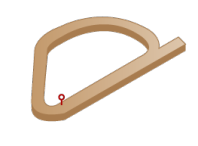Race type - Mixed
Doncaster
Course details
The flat nature of the track and underfoot conditions place a distinct emphasis on speed over stamina and horses who like to get on with it often prevail, whereas the stoutly-bred staying types are taken off their feet.

GUIDE - For Racecourse
Left-handed, mixed, pear-shaped circuit of 1m 7.5f, spur provides straight mile
They've been racing on Doncaster Town Moor since 1776 when, to coincide with the opening, the first running of the St Leger Stakes took place, making it the oldest of the five English Classics. These days, the race forms part of the prestigious four-day St Leger Festival in early September and the standard of flat racing here is generally high. Three important years in the course's history are: 1964, which is when it inherited the Lincoln and November Handicaps on the closure of Manchester; 1992, when the first Sunday meeting took place here in front of a crowd of 20,000 plus; and 2007, when it underwent a £34m redevelopment, thus making it one of the most modern race tracks in Britain and well worth a visit.
Track / Draw Bias
There has never been any draw advantage in races on the round course and any previous advantage in straight-course races has largely been absent since the course was redeveloped. That said, there does seem to be some advantage in being drawn either very high or very low on the straight course in big fields as the centre of the track tends to ride slowest, with the Lincoln Handicap (1m) a good case in point. In smaller fields on the straight course, the runners tend not to split and the far side of the track (low numbers) is perhaps slightly favored.
Principal Races
The St Leger, which is for three-year-olds over a distance of 1m6f, is not only the final Classic of the season but also the final leg of the 'Triple Crown' for both colts and fillies. These days, however, it's rare for the winners of the first two legs - the 1000 Guineas & Oaks for fillies, 2000 Guineas & Derby for colts - to even line up and the race now tends to go to a late maturing type. The Doncaster Cup over 2m2f, run at the same September meeting, has a rich history and attracts the best stayers, while the Flying Childers Stakes over 5f gives the sprinters a chance to show off. Fast forward a month to the Group 1 Racing Post Trophy over 1m, which is an established end-of-season target for the best staying juveniles. The winner nearly always goes into the winter as favourite for the following year's Derby, with the 2011 winner Camelot being the latest example.
The track's main betting races, though, are the big-field handicaps run here at the start and end of the flat race season. The Lincoln Handicap is run over the straight mile in March and heralds a new flat campaign, while the November Handicap over 1m4f brings down the curtain. Both are always fiercely competitive with maximum fields, which is why bookmakers love them and the Lincoln is advertised as the second leg of Spring Double' after the Grand National, tempting punters to have a crack at it. The Portland Handicap is run over the specialist distance of 5f 140yds and trainers of horses than run well in it tend to keep returning them, with Halmahera, who won the race three times on the trot between the ages of seven and nine, by far the most successful to date.

Course Characteristics
The redevelopment included significant improvement to the drainage and condition of the turf and it is now without doubt one of the finest racing surfaces in the country. The racing circuit is nearly two miles in circumference and is mostly flat with the exception of the Rose Hill, which is a natural phenomenon and a chute there provides the start for 1m races on the round course. The home straight of around 4f is joined at the far end by a further chute of 4f, which creates a straight mile course for all races up to that distance. All in all, it's a very fair course and horses that like to stretch out and gallop are in their element.
Top Trainers
The winners tend to be shared out equally at this Grade 1 venue, although the two Richards, Fahey and Hannon, get more than their fare share with 30 and 26 winners respectively over the past five seasons. Of the pair, it's Hannon who has the best strike rate of 17% and backers of all his runners would have enjoyed a healthy level states profit of over £40. Of the Newmarket trainers, top honours goes to John Gosden, who sends out a consistent stream of winners throughout the season at a strike rate of over 20%, but does particularly well in the autumn and has won three St Legers since 2007. Other trainers worthy of mention are Mark Johnston and the up-and-coming Roger Varian, who took over from Michael Jarvis in 2011 and made a great start with five of his 10 runners here obliging.
Top Jockeys
Paul Hanagan has been on the majority of Richard Fahey's winners here and leads the way numerically with 27 winners. Just don't follow him blind as he rides plenty of losers too as evidenced by his strike rate of 12%. Frankie Dettori rides the track superbly and there is no better judge of pace from the front. Back him when he's riding a sole confirmed front-runner for Godolphin especially. Gosden's stable jockey William Buick rides plenty of winners here, as you'd expect, while anything ridden by Jamie Spencer and Ryan Moore should always be given a second look.